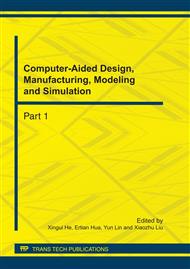p.596
p.604
p.610
p.615
p.623
p.628
p.632
p.638
p.642
Finite Element Analysis of Vibratory Stress Relief Process
Abstract:
The process of stress vibratory relief is gaining more and more weight as manufacturing process. This is mainly due to the fact that vibratory stress relief has the advantage of low energy consumption and dramatic reduction of pollution to the environment in respect to traditional thermal stress relief process. A finite element model is developed for the simulation of vibration stress relief (VSR) process. A cantilever beam was pre-stressed and then subjected to transverse cyclic force to see the effect of vibration frequency, time and amplitude on the reduction of residual stress. It was shown that the excitation frequency and amplitude of the load on the beam had great effect on the reduction of the residual stress. Increasing vibration time can decrease the magnitude of residual stress, but its influence reduces greatly after several cycles.
Info:
Periodical:
Pages:
623-627
Citation:
Online since:
August 2011
Authors:
Keywords:
Price:
Сopyright:
© 2011 Trans Tech Publications Ltd. All Rights Reserved
Share:
Citation:


